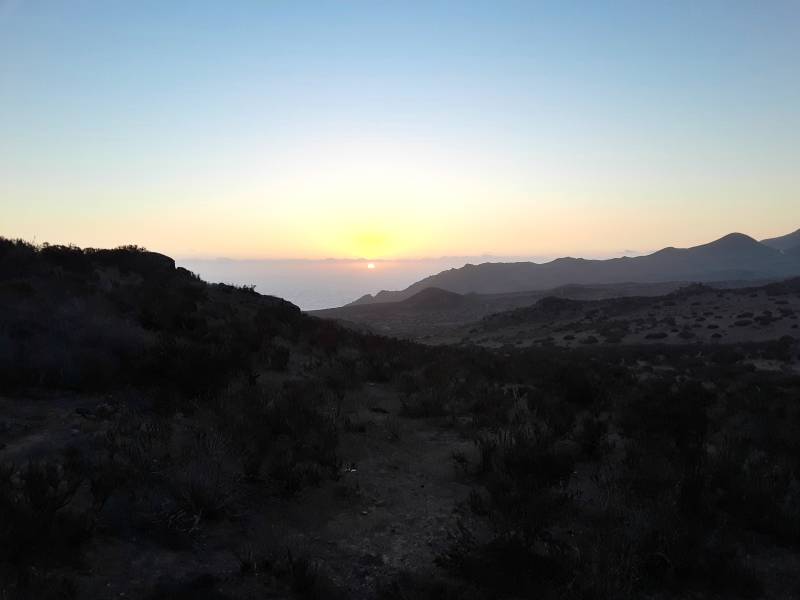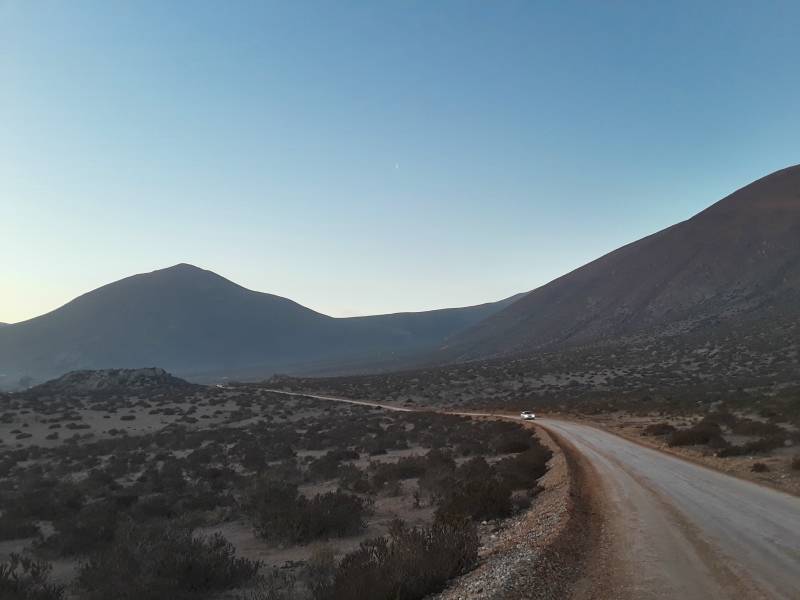
Total Solar Eclipse
Preparation
Some friends of mine were organizing a trip to the
total solar eclipse of July 2, 2019.
Was I interested?
Yes!
The path of totality was mostly in the southern Pacific
Ocean, but toward the end it came ashore across the
Coquimbo Region in Chile.
The Atacama Region, just to the north, contains
the driest desert in the world.
Coquimbo Region is dry and clear enough that
several prominent astronomical observatories
are located there.
I had missed out on the 2017 total eclipse
that crossed the U.S.
My friends had traveled to that one,
and now called themselves umbraphiles.
Dry north-central Chile has the best
observing conditions in the world.
Plus, what else was going to get me to Chile?
Even if the eclipse was covered by clouds,
it would be interesting.
Chile promoted eclipse observation and tourism at the national, regional, and local levels.
Astronomical research facilities in the Coquimbo Region include:
- Cerro Tololo Inter-American Observatory
- Cerro Pachón
- La Silla Observatory
- Las Campanas Observatory
- Cerro El Roble Observatory
North of there in the Atacama Region are:
- Llano de Chajnantor Observatory
- Atacama Submillimeter Telescope Experiment
- NANTEN2 Observatory
- Paranal Observatory
- Atacama Large Millimeter Array
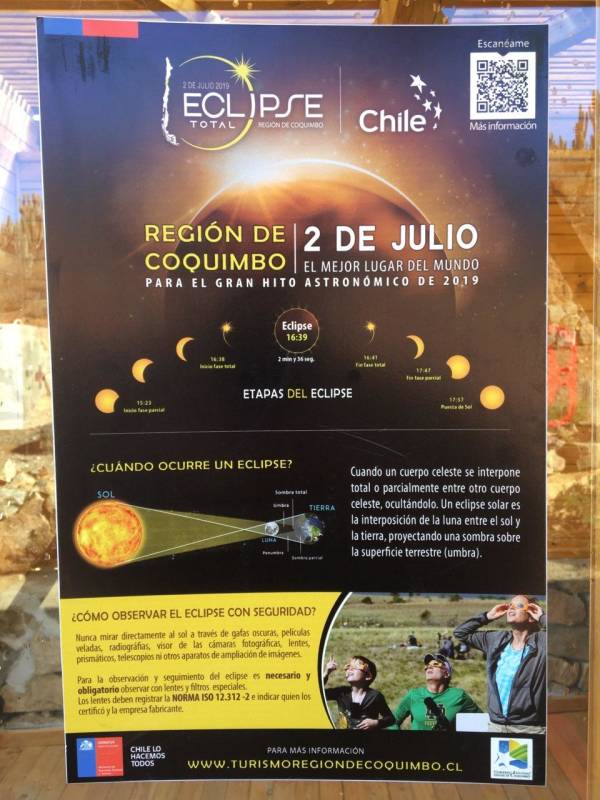
They didn't talk anyone else into going all the way to Chile to not see the Sun for two and a half minutes, so it was just the three of us.
I arrived in Chile about a week ahead of time. I stayed two nights in Santiago, three in Valparaíso, and then went by bus to La Serena, about 575 kilometers north of Santiago. I stayed there for two nights at the Aji Verde hostel. My friends flew into Santiago and stayed one night there. Then they picked up the rented Jeep and drove north to Coquimbo, where they had rented a condominium through AirBnB. I moved from La Serena to Coquimbo, and we were ready to go.
Driving North on Ruta Cinco
The government estimated that about 300,000 people visited the area of La Serena and Coquimbo for the eclipse.
They would experience totality in those cities, but we wanted to go north and be on the centerline of the path of totality. That would maximize the totality time, giving us 2 minutes and 38 seconds of totality.

We drove north on Ruta 5, or Chile's Highway 5. It runs for 3,364 kilometers from the northern tip of Chile to as far south as you can practically build a highway in Chile. It's part of the Pan-American Highway, which almost completely links the southern tip of South America to the Arctic Ocean coast.
As we neared the eclipse centerline, we saw more and more cars pulled off the highway.
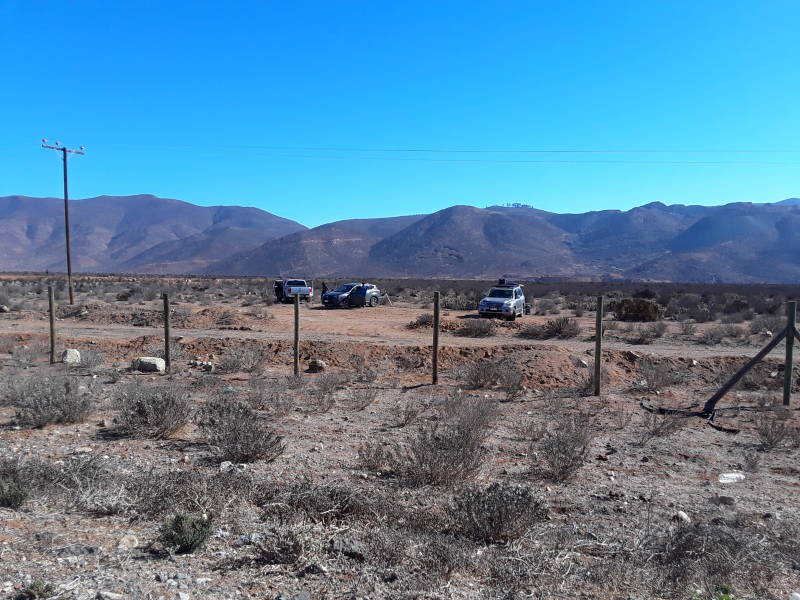
La Higuera is a small community and commune (or lowest-level administrative district) north of La Serena and Coquimbo, almost exactly on the totality centerline.
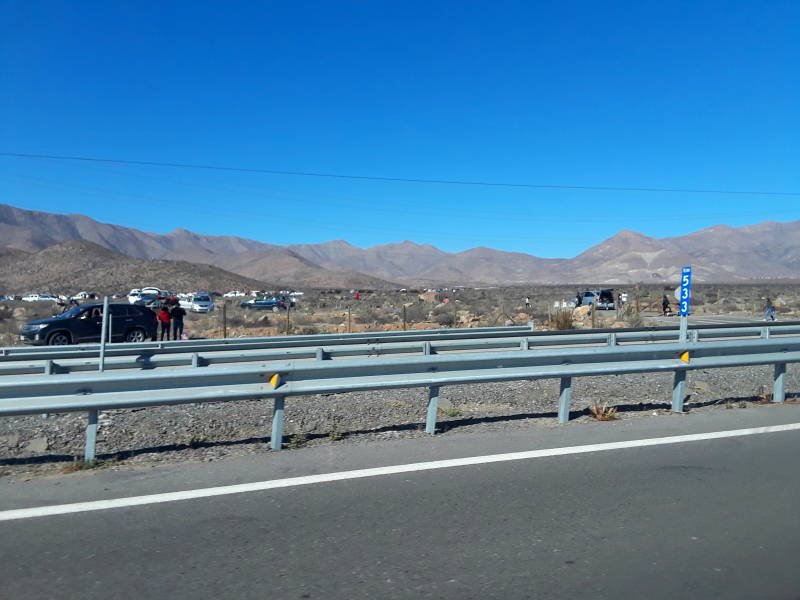
The commune covers about 4,200 km2 with a population of about 4,300. Just 1,080 people live in the town of La Higuera and other, smaller, communities. La Higuera is visible in the distance above and below.

There seemed to be thousands of cars parked in the open plain between Ruta Cinco and La Higuera, in what had become a large campground.
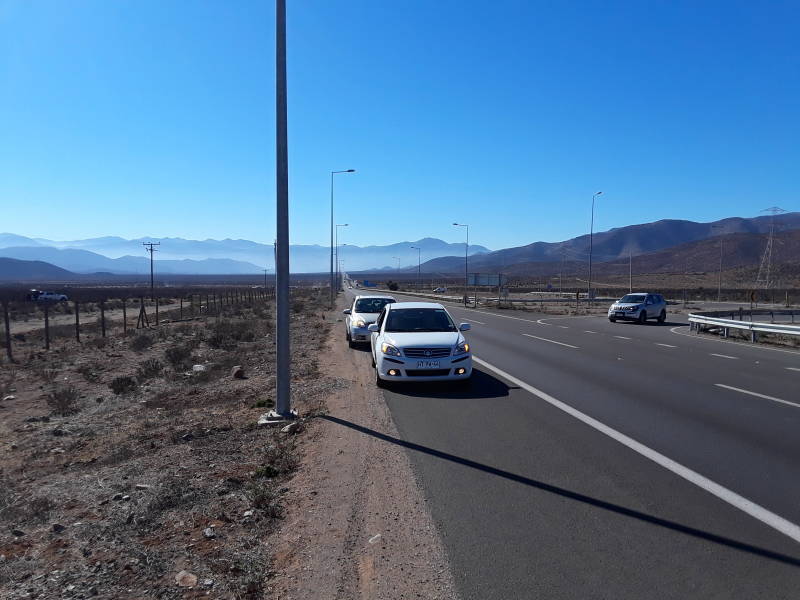
We turned around at a Retorno and headed back to the south. We had a location picked out between the coastal range and the shoreline.
Local road D-190 would get us to the general area, and then we would take our rented Jeep off road.
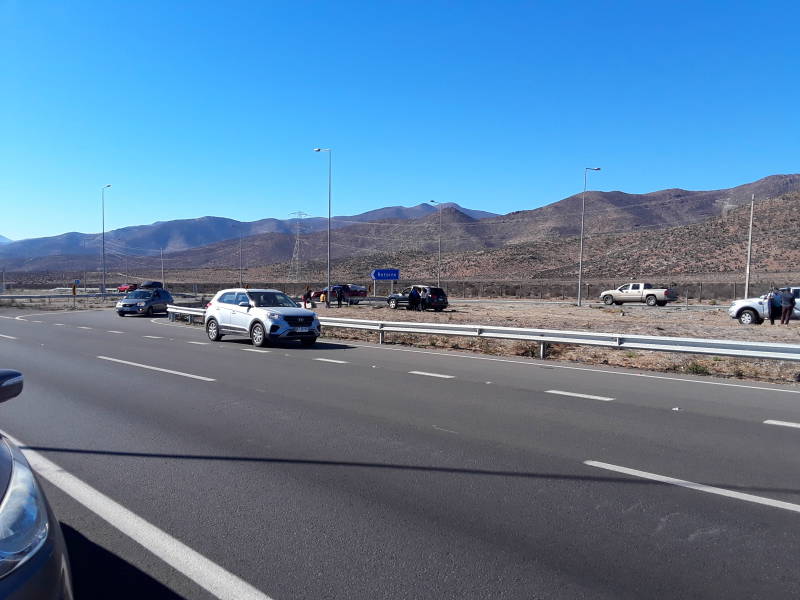
Our Observation Point
Exactly where were we? Unix-family command-line utilities can tell us.
-
Extract the multi-line EXIF JPEG metadata blocks
from the picture collection with
jhead, then -
Save just the lines containing either "Lat" or "Lon"
with
egrep, then -
Sort those into order with
sort, then -
Count the number in each group with
uniq -c, then -
Sort those counts into reverse numeric order with
sort -nr, and -
Only keep the counts larger than 2
with
awk
Expanding the awk command to calculate a
weighted average is left as an exercise for the reader.
$ jhead *.jpg | egrep 'Lat|Lon' | \
sort | \
uniq -c | \
sort -nr | \
awk '$1 > 2'
29 GPS Longitude: W 71d 18m 55s
29 GPS Latitude : S 29d 34m 4s
8 GPS Latitude : S 29d 34m 3s
5 GPS Longitude: W 71d 18m 56s
5 GPS Longitude: W 71d 18m 53s
4 GPS Longitude: W 71d 18m 54s
4 GPS Longitude: W 71d 18m 28s
4 GPS Longitude: W 71d 12m 28s
4 GPS Latitude : S 29d 42m 2s
4 GPS Latitude : S 29d 28m 1s
3 GPS Latitude : S 29d 34m 7s
3 GPS Latitude : S 29d 34m 5s
We were at 71° 18' 55" W, 29° 34' 4" S.
This 1:500,000 map shows terrain and elevations. It's Tactical Pilotage Chart Q-26C, from the University of Texas' Perry Castañeda Library Map Collection. The settlement marked as Yerbas Buenas is a house. We were at Punta la Calavera looking northwest over Isla Tilgo.
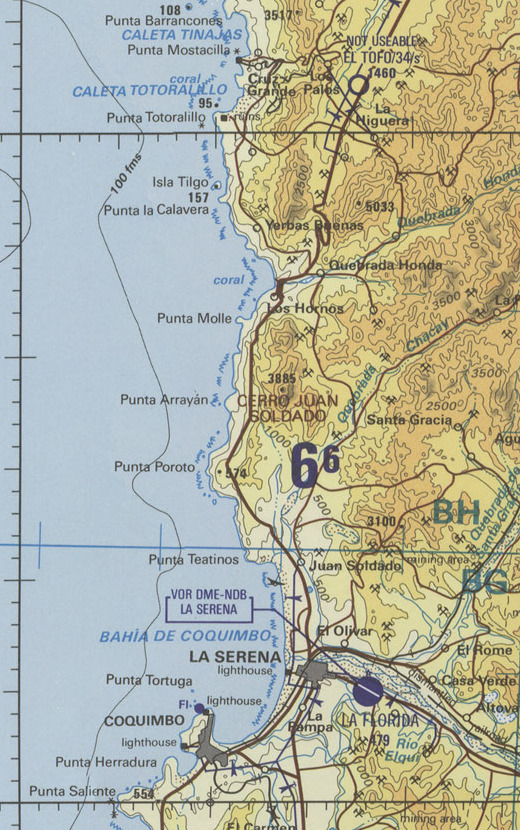
Below is Joint Operations Graphic SH19-09, which is 1:250,000 scale and shows more detail. It shows the secondary road degrading to a track at Yerbas Buenas, which seems about right.
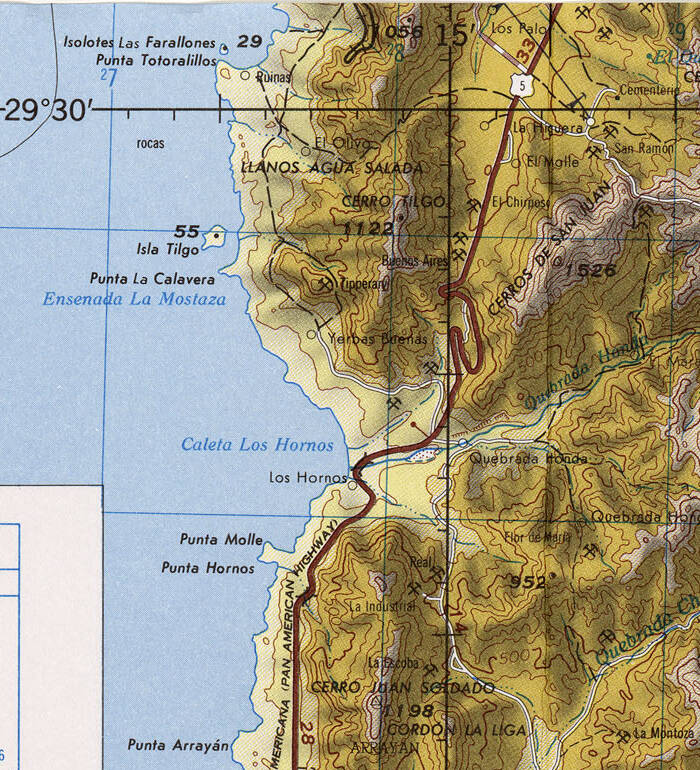
As Buzz Aldrin said about the Moon: "Magnificent desolation"

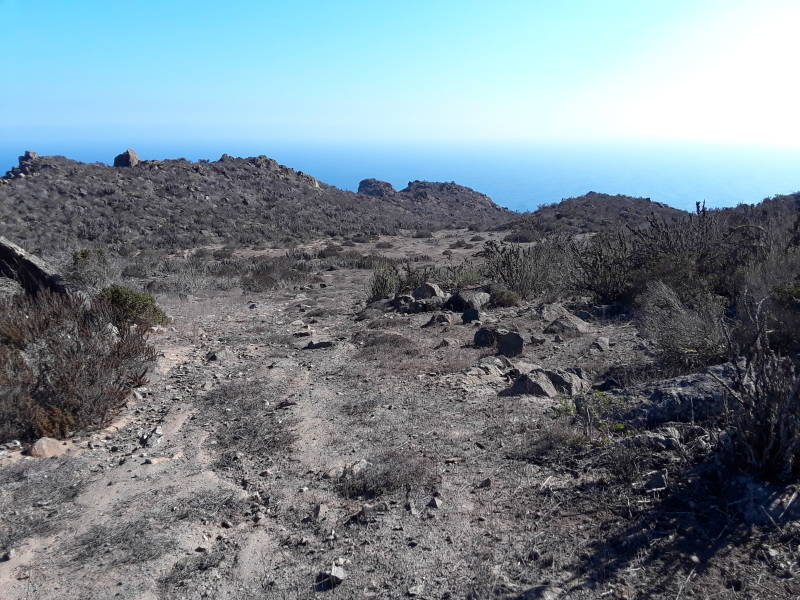
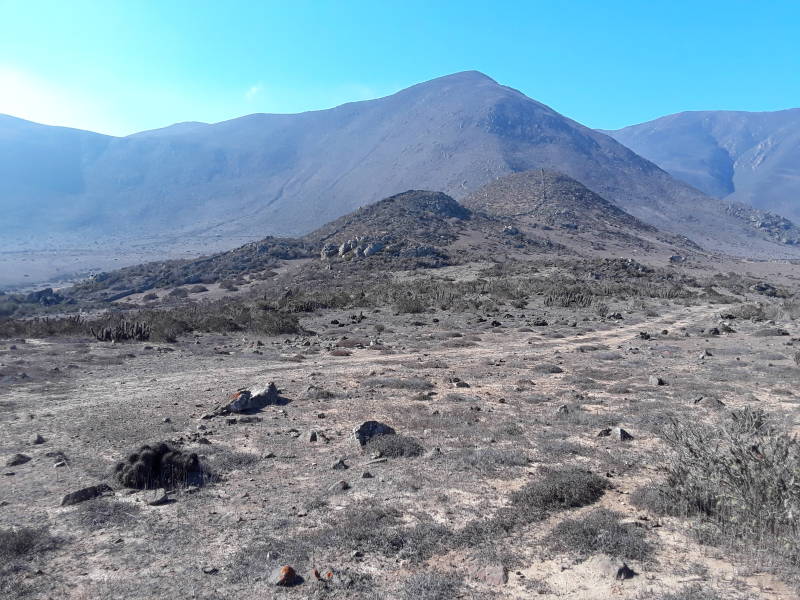
Here we are: Keith, Janet, and me.
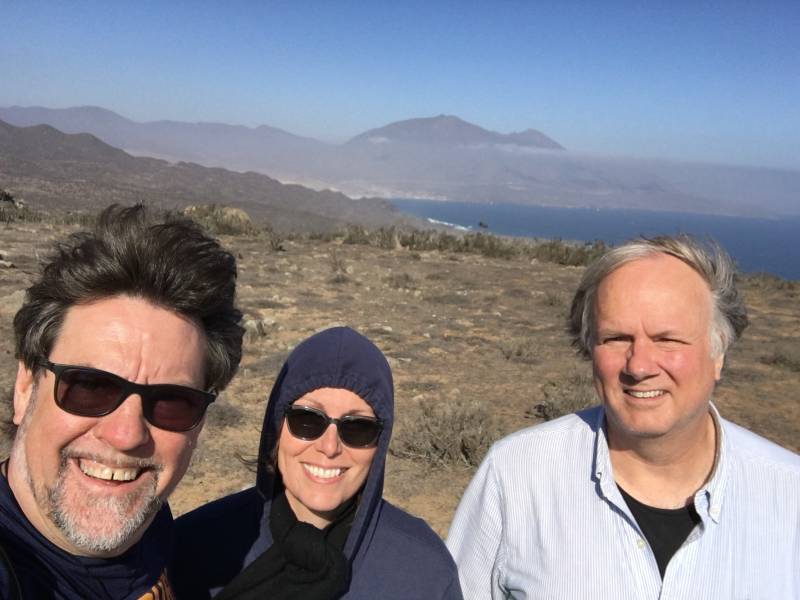
It's arid, but not devoid of plant life. It's dry and sandy and prickly. For nearly sterile deep desert, you need to head north into the heart of the Atacama.

Amazon
ASIN: 0441172717
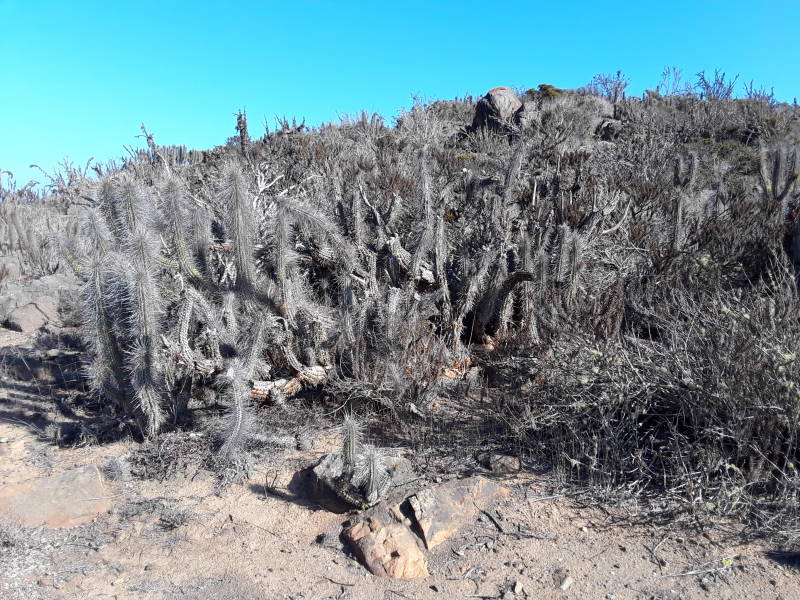
To the south, we overlooked a bay where Highway 5 ran close to the shoreline.
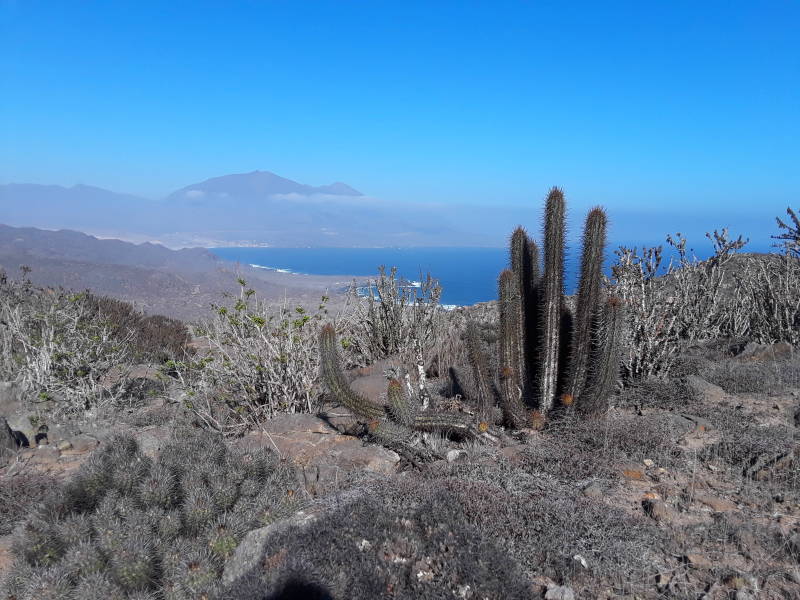
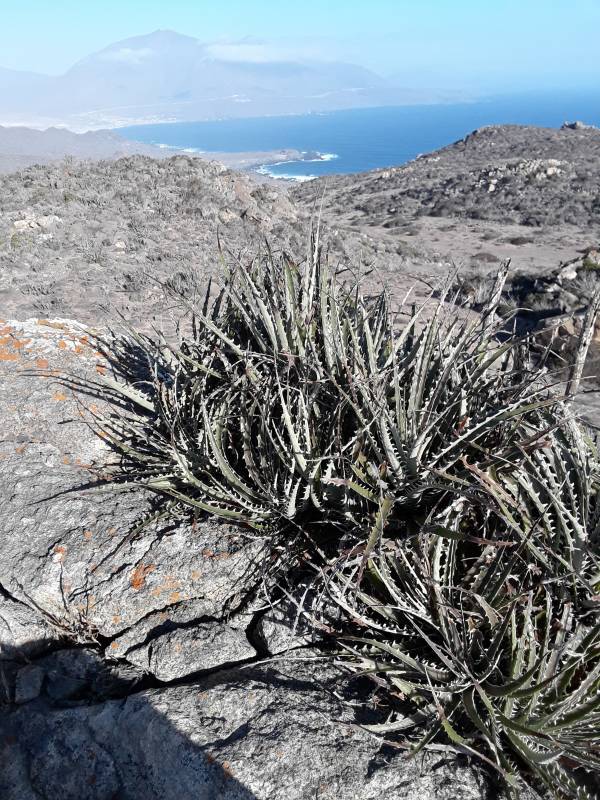


There's quite a lot of orange lichen on the rocks. But very little in dry shades of green.
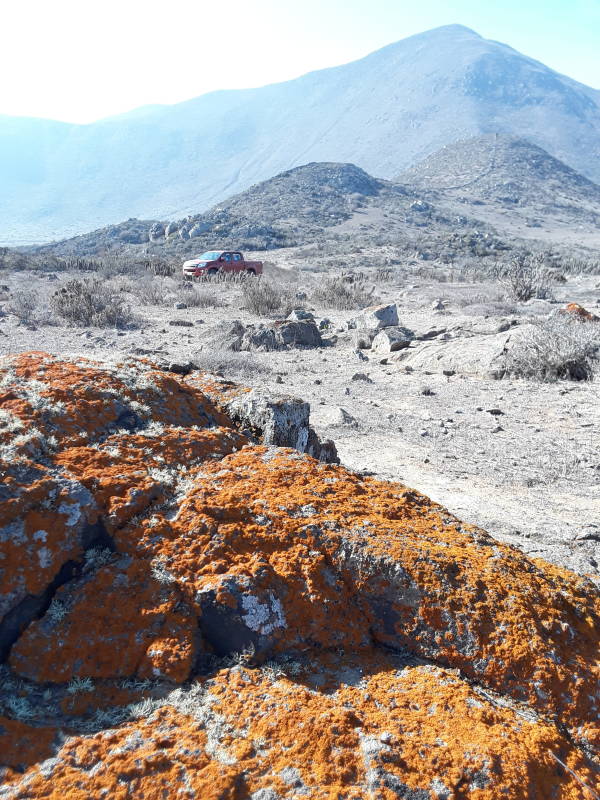
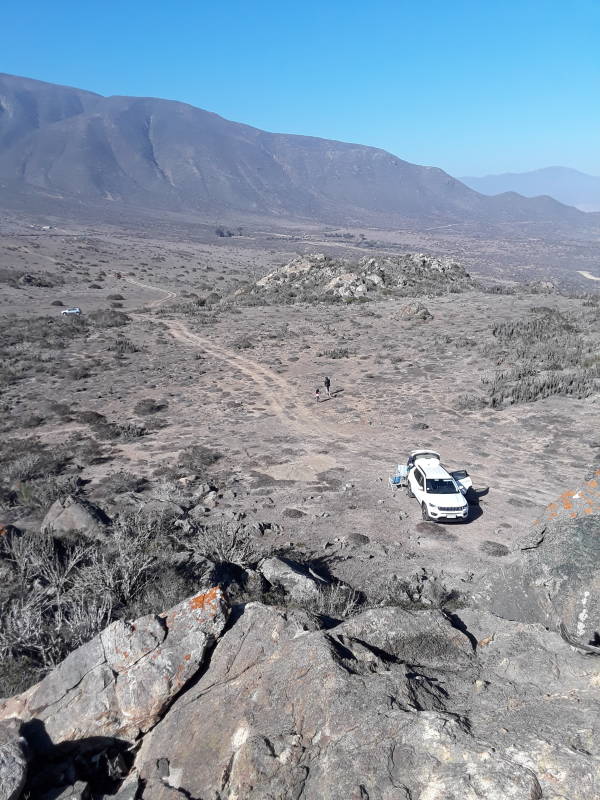
In the last picture above, you see our white Jeep and the rough track we took from D-190, barely visible in the distance.
I've gone up on a rock outcropping, looking for the ultimate observation point. A man and a fairly young boy are walking from their silver vehicle parked in the distance.
Below, a family from the area has set up their cookout on the flat area.

Here's Keith with Romanieo Golphin, Jr. By the time I got back down, Keith and Janet were talking to Romanieo and his dad.
Romanieo Sr studied biology and piano at Howard University, then composition and orchestration at the Juilliard School, and then Russian at Lomonosov Moscow State University. And along the way he picked up Mandarin.
Keith recognized Romanieo Jr from his recent appearance on the Jimmy Kimmel Show, where he was explaining how observations made during a total solar eclipse can verify Einstein's theories. He has been taking college-level science courses for a few years now.
You meet interesting people at eclipses.
Keith is holding ISO-certified eclipse glasses. I already had a spare set, as they were being sold cheaply in La Serena and even given away in bars. Buy an El Completo, get a pair of eclipse glasses. ISO certified, of course. Chile takes its astronomy seriously.
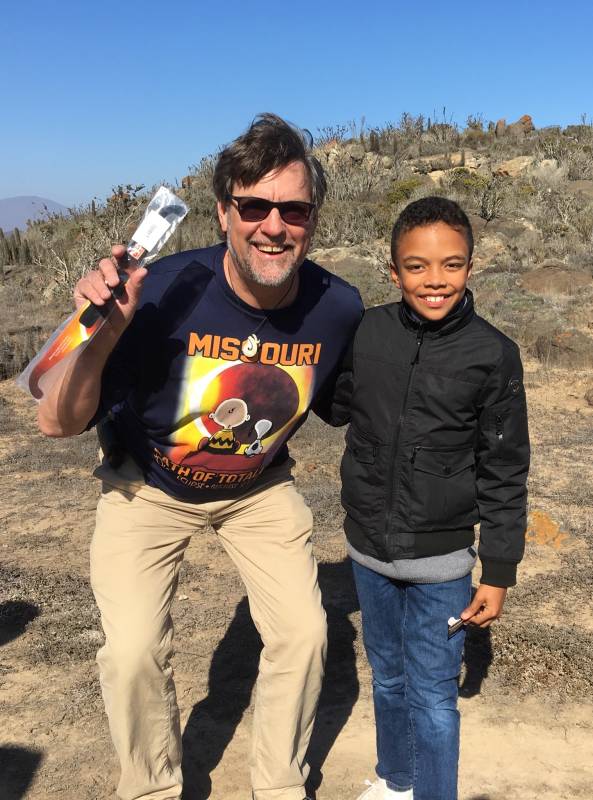
First Contact
The eclipse begins! This is at 15:40:22 local time.
I took most of the pictures on this page on my older Samsung Android phone. Keith Alyea took the really good ones like this one, with solar filters and long focal lengths. He's available for weddings, bar mitzvahs, and astronomical phenomena.
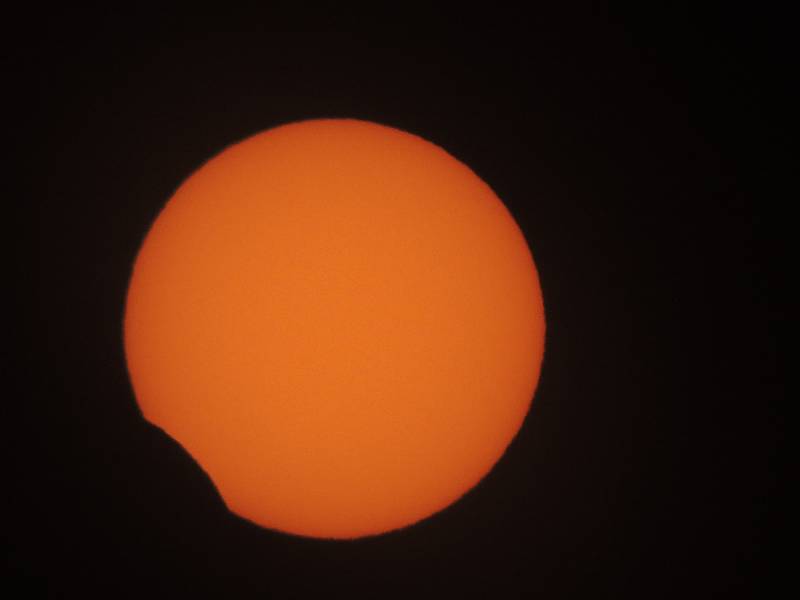
I've gone back up for another look around. Keith and Janet are down by the jeep, which will be in the shadow of the rock outcropping before long.
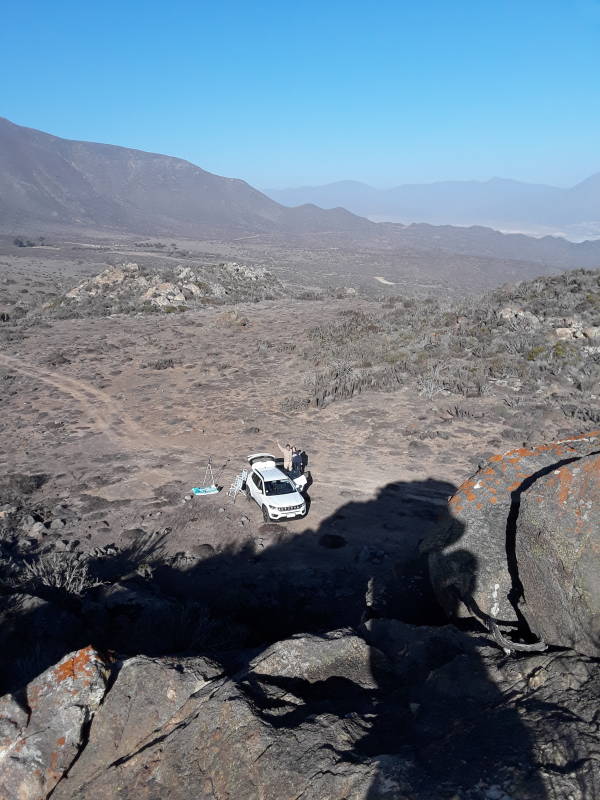
It's very clear, with just a few light clouds near the ridge tops where the moist air off the ocean rises up over the coastal range.
The weather generally moves toward the southeast here, coming in off the ocean. But the ocean is very cold, with the Humboldt Current flowing north along the coast from Antarctica. The air moving onshore is relatively dry, unlike coastal Alaska, British Columbia, and Washington, where moist ocean air makes for temperate rain forests.

The rugged terrain is caused by geophysics. The Atacama Trench, or the Peru–Chile Trench, reaches a depth of over 8,000 meters just off the western coast of South America. The trench is the result of the Nazca Plate subducting or irregularly moving beneath the South American Plate.
The plate movement causes the Andes mountain chain, the coastal mountain chain in Chile, and the general roughness of terrain, and the irregularity causes the frequent severe earthquakes. The MW 9.5 earthquake near Valdivia in 1960 was the strongest earthquake ever recorded.
Here's the view from this rock outcropping toward the direction of the eclipse. Two guys have set up on the next outcropping.

Back down by the jeep, Janet and I look at the small slice covered by the Moon so far.

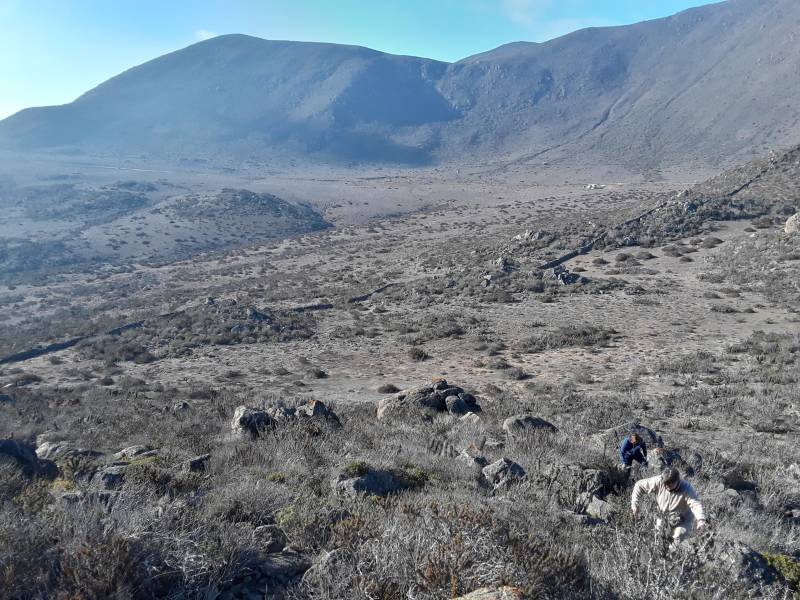
I've gone back up, and here come Keith and Janet.
Someone put in a lot of work assembling a dry stone wall.
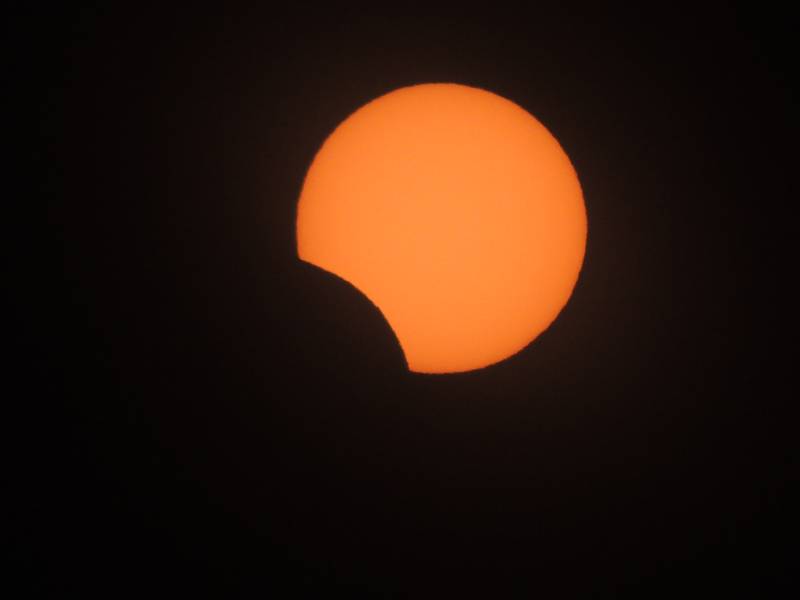
The Moon progresses across the face of the sun.

The guys on the next outcropping have set up their cameras, and Keith gets his ready.

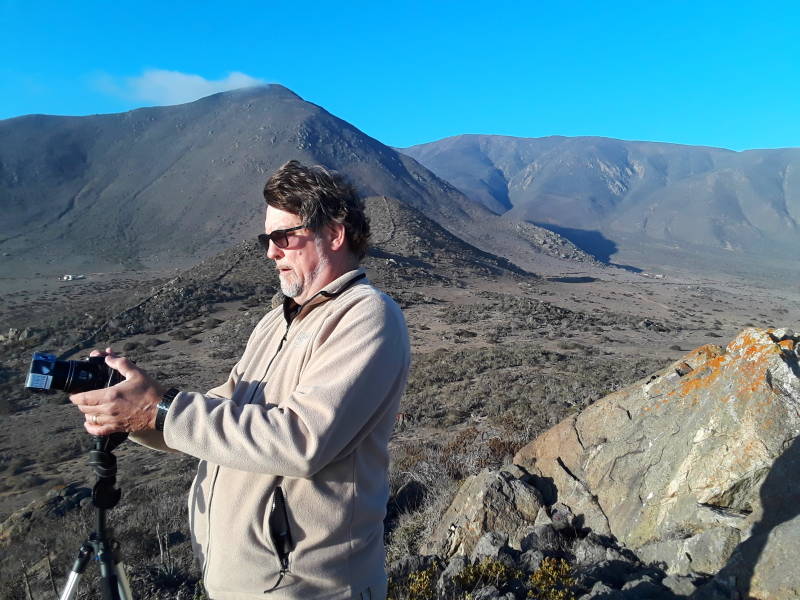
By 16:33:14, the eclipse is at least as great as the most complete one I had seen, two years before.
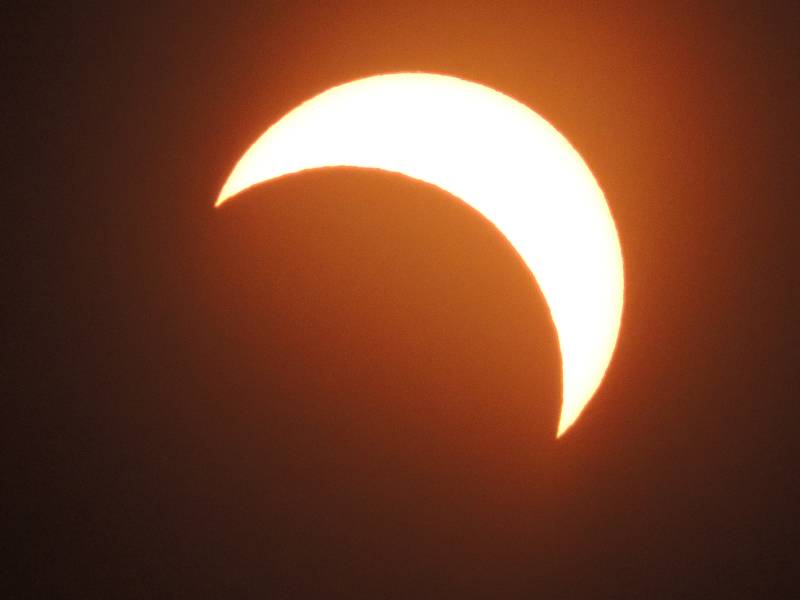
The light gets very strange, a sort of silvery but weak light. Cameras just don't capture it.
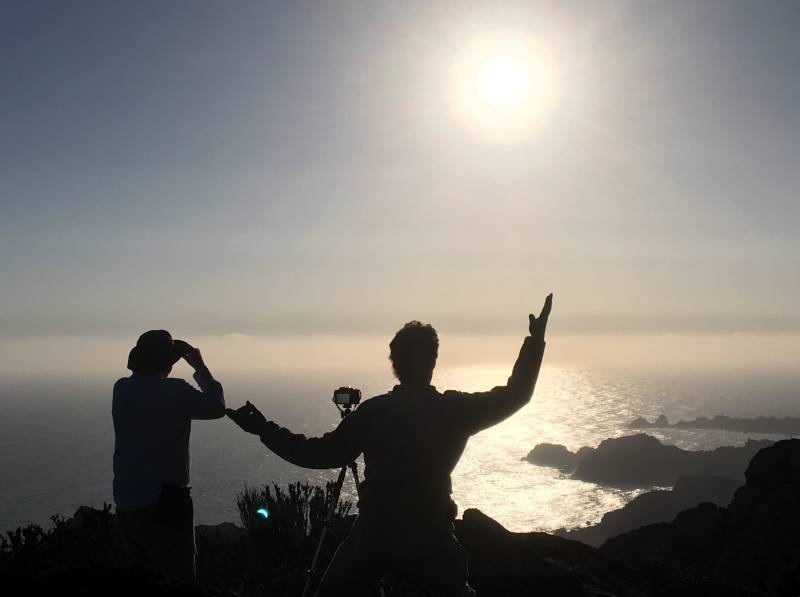
At 16:42:35, as shown above, it is nearing totality. The camera's automatic gain control is overwhelmed, and the lighting looks nearly normal.
It wasn't.
Notice the lens flare at lower left in the picture above, showing the crescent shape of the exposed Sun.
Below is the thin crescent remaining at 16:50:00

Below, at 16:52:08, it is at the "diamond ring" stage where one or a few small spots are exposed through irregularities along the limb of the Moon.
Basically, just a tiny spot or two or three show through mountain passes on the Moon's horizon.
The red tint to either side of the overexposed area, plus a reddish area on the opposite side, may be from prominences extending out from the Sun's surface.
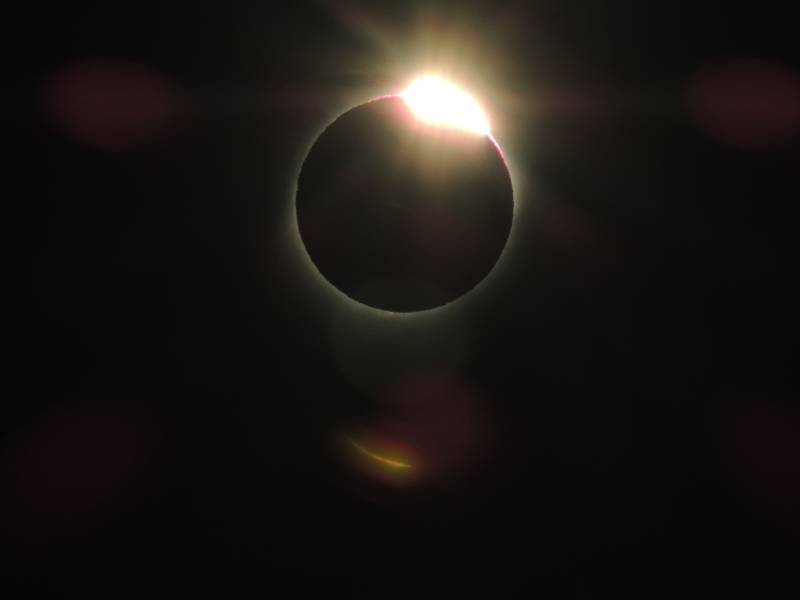
Totality
Totality! Below is the view at 16:52:40, as our 2 minutes and 38 seconds of totality begin.
This eclipse had an eclipse magnitude of 1.0459, meaning that, at its peak, the Moon had an apparent diameter 104.59% that of the sun, and so the Sun was totally covered for more than just an instant. The 2017 eclipse across North America had an eclipse magnitude of 1.0306, the December 2020 eclipse in Chile will be 1.0254.
Out in the middle of the Pacific Ocean, totality lasted for a maximum of 4 minutes and 32 seconds.
Here in Chile, the eclipse was occuring near sunset, putting us close to one-half the diameter of Earth further away from the Moon. That makes the umbra or total eclipse footprint smaller and of shorter duration.
But still, we had over two and a half minutes due to our driving to this location on the totality centerline.

Below is the result of doing a localized histogram equalization with a radius of 100 pixels on the original 4608×3456 pixel image, then downsampling that to 800×600.

And the same thing with a radius of 50 pixels. Yes, it's largely sensor noise, but there is quite a bit of real texture in the corona.
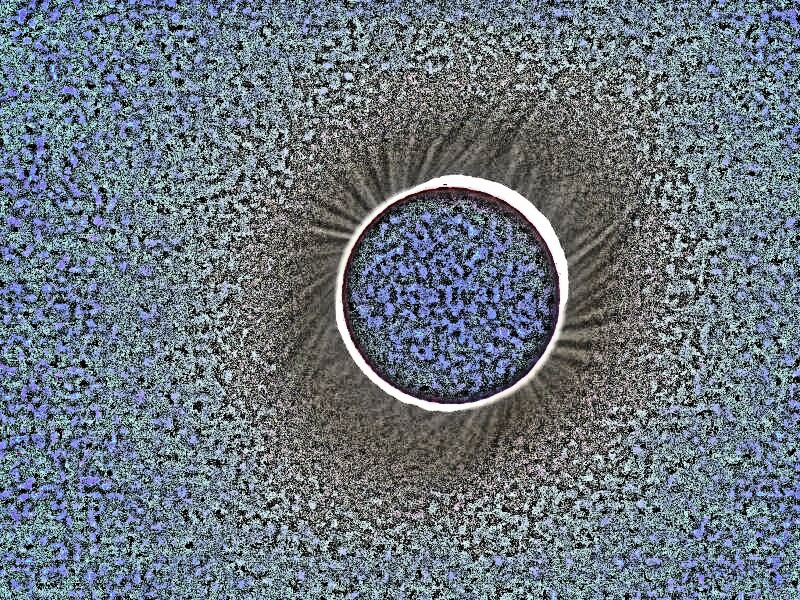
The eclipse is very strange, pictures just don't capture it.
The black of the Moon's disk is incredibly black, surrounded by the bright silver of the Sun's corona.
Venus became visible, to the lower left in the below picture.
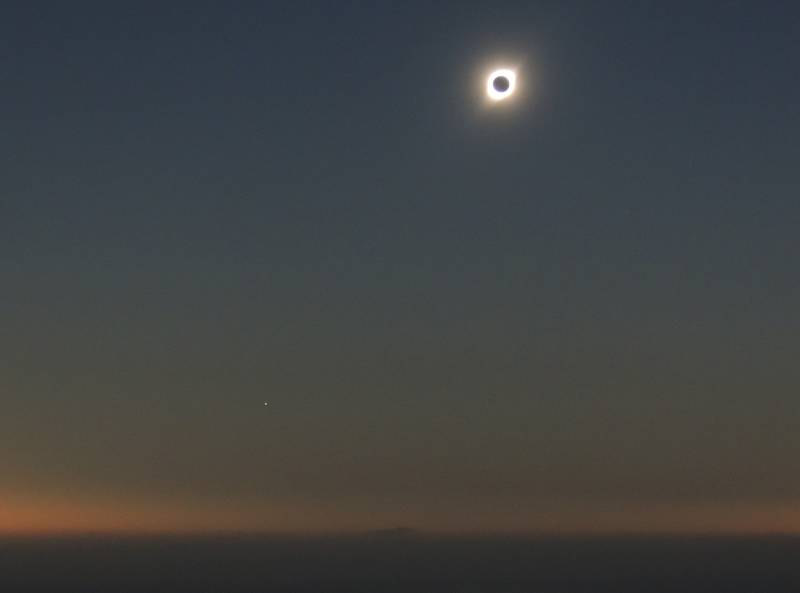
It's dark, not as dark as the middle of the night, but still quite dark.
When you're in the umbra, there is partly lit penumbria area all around you. That makes the overall sky very strange.
Most of the sky is like an hour or more after sunset or before sunrise. But around sunset and sunrise, one area along the horizon, above the sun, is the lightest, and all the sky gets darker as you look further from the sun.
During a total eclipse, the darkness is centered on the eclipsed sun, and there is glow all around the horizon.
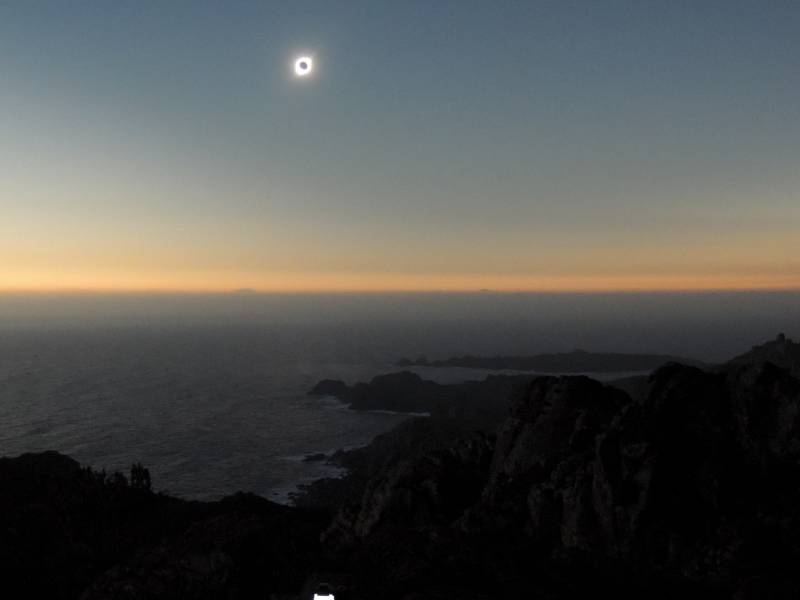
The Sun Returns
At 16:55:04, the Moon had moved on and a small area of the sun was exposed on the opposite side.
Prominences are clearly visible here.
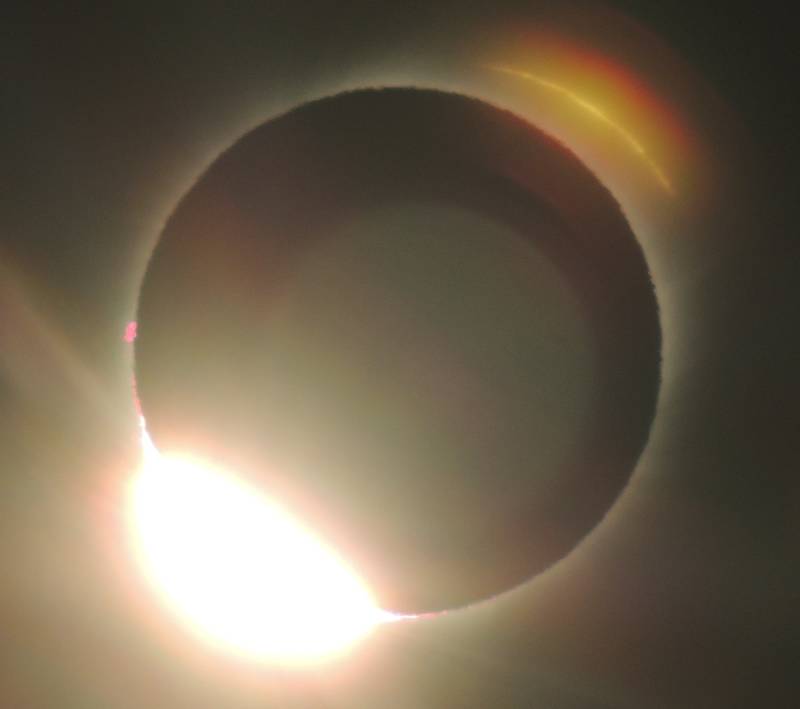
The Moon was moving, as always, from west to east relative to the Sun. That meant, from our vantage point in the Southern Hemisphere in late afternoon, from lower left to upper right.
This eclipse happened when the moon was at its ascending node, moving generally northward through its orbit where it intersects the Earth's orbital plane around the Sun.
The Arabs had all this figured out in medieval and early modern times, calling the ascending node ra's al-hauzahar or "the dragon's head".
Ask Buzz Aldrin, who earned a Ph.D. in orbital mechanics.
A broad crescent was exposed by 17:14:58, and our surroundings were returning to normal appearance, although dimmer than normal.
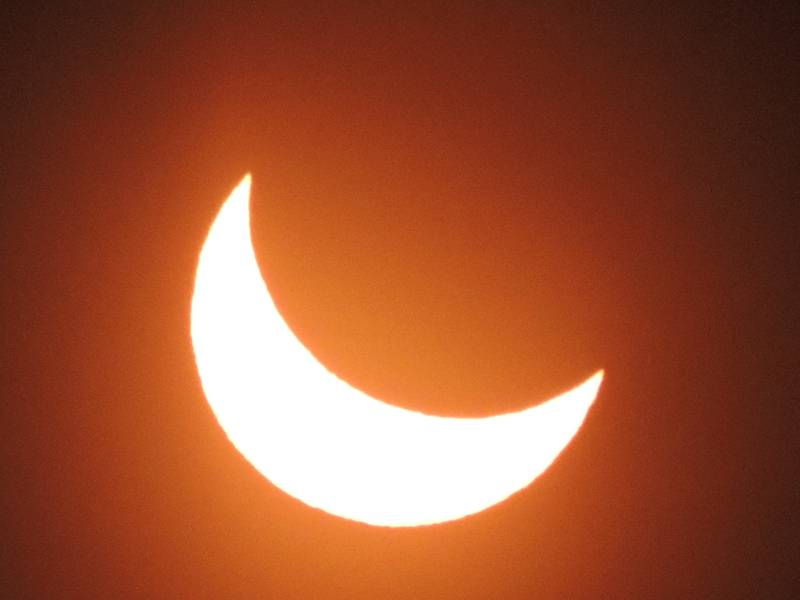
Returning to Coquimbo
The sun was setting by 17:55, and we had packed up and were returning to Highway 5.
